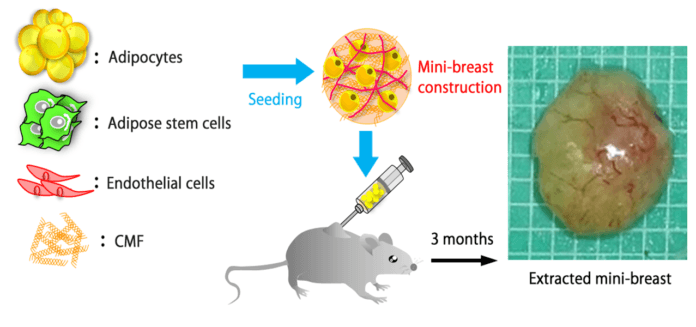A team of researchers from Osaka University, Kyoto Prefectural University of Medicine, and Toppan Printing succeeded in reconstructing adipose tissue balls (mini-breasts) with a functional vascular network using patient-derived cells. The research has achieved a high graft survival rate in small animal models.
So far, silicone breast implants were primarily used in breast reconstruction following mastectomy. In Japan, the breast implant manufactured by Allergan was the only product approved by the Ministry of Health, Labor, and Welfare. In July 2019, however, the US Food and Drug Administration (FDA) requested Allergan to recall its breast implants due to the risk of breast implant-associated anaplastic large cell lymphoma (BIA-ALCL), and their production was discontinued.
Although autologous tissue-based breast reconstruction, in which the patient’s fat cells are collected and injected, has also been performed, the graft survival rate is low, and outcomes vary with the patient’s background. Some patients have to undergo several transplant surgeries.
In this study, the research team used type I collagen microfibers (CMFs) and applied their unique tissue engineering technique to the production of mini-breasts. CMFs act as a scaffold for adipocytes, adipose-derived stem cells, and vascular endothelial cells. The fabricated vascular network supplies the cells with nutrients and oxygen, and the connection between the mini-breast and the patient’s blood vessels was also established. Transplanting this mini-breast into small animals resulted in a graft survival rate twice as high as that of conventional aspirated fat tissue transplantation.
Since cells derived from patients are used, no inflammatory reaction was observed, indicating that the mini-breasts are highly safe. Furthermore, the volume of the mini-breast to be implanted is adjustable by in vitro culture. “Our findings will lead to a new, highly safe breast regenerative medicine that can replace the conventional fat cell injection and implantation,” says Matsusaki, who led the study.
The technique used in this study was introduced in “3D collagen microfibers stimulate the functionality of preadipocytes and maintain the phenotype of mature adipocytes for long term cultures,” and published in Acta Biomaterialia at DOI: https://doi.org/10.1016/j.actbio.2018.11.048.






